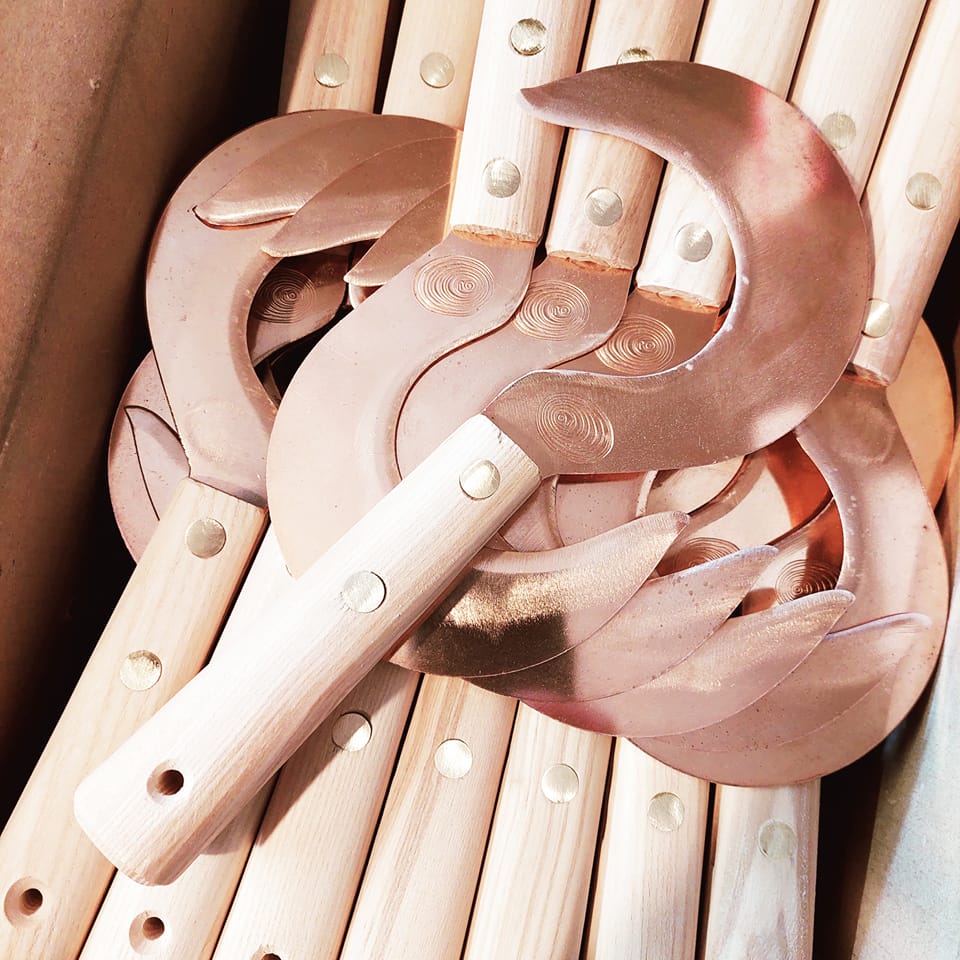Copper is a soft, reddish metal. Due to its high electrical conductivity, large amounts of copper are used by the electrical industry for wire. Of all pure metals, only silver has a higher electrical conductivity. Copper is also resistant to corrosion caused by moisture, making it a widely used material in pipes, coins, and jewelery. Copper is often too soft for its applications, so it is incorporated in numerous alloys. For example, brass is a copper-zinc alloy, and bronze is a copper-tin alloy. Copper sulfate (CuSO 4·H2O), also known as blue vitrol, is the most well-known copper compound. It is used as an agricultural poison, an algicide, and as a pigment for inks. Cuprous chloride (CuCl) is a powder used to absorb carbon dioxide (CO2). Copper cyanide (CuCN) is often used in electroplating applications. Copper is available as metal and compounds with purities from 99% to 99.9999% (ACS grade to ultra-high purity); metals in the form of foil, sputtering target, and rod, and compounds as submicron and nanopowder. The origin of the word copper comes from the Latin word 'cuprium' which translates as "metal of Cyprus". Cyprus, a Mediterranean island, was known as an ancient source of mined copper. Copper, American Elements
Copper is essential to all living organisms as a trace dietary mineral because it is a key constituent of the respiratory enzyme complex cytochrome c oxidase. In molluscs and crustacea copper is a constituent of the blood pigment hemocyanin, which is replaced by the iron-complexed hemoglobin in fish and other vertebrates. The main areas where copper is found in humans are liver, muscle and bone. Copper compounds are used as bacteriostatic substances, fungicides, and wood preservatives. Wikipedia, Copper
Copper is an essential micronutrient, There are about seven nutrients essential to plant growth and health that are only needed in very small quantities. These are manganese, boron, copper, iron, chlorine, molybdenum, and zinc. Though these are present in only small quantities, they are all necessary.
Copper is a component of some enzymes. Symptoms of copper deficiency include browning of leaf tips and chlorosis. Wikipdeia, micronutrient
Schauberger
During early and late frosts experienced farmers protect their blossoming orchards by spraying water onto iron or steel plates through a system of paramagnetic[16] nozzles, which results in an immediate rise in temperature of about (6°C - 10.8°F) in the crown zone. This water cannot mix with the differently charged surrounding air and remains unchanged even under the severest frost. This works incomparably better than artificial smoke generators (smudge pots), which are also known to protect the delicate blooms against freezing. If the above process is carried out with copper nozzles, then a conspicuous cooling occurs in the crown zone, which can be used to safeguard sensitive young shoots and protect them from scorching. This is especially necessary in the case of young light- and heat-sensitive seed-stock, which are often shielded from sunburn with leafy cuttings. [The Energy Evolution - Harnessing Free Energy from Nature, The Catalysts]
[16] List of paramagnetic and diamagnetic elements:
1. Apart from iron, nickel and cobalt, whose magnetic properties are already known, osmium and almost all iron compounds are paramagnetic metals.
2. Bismuth and antimony are particularly diamagnetic. Zinc, tin, lead, copper, silver and gold as well as glass and carbon disulphide and other non-conductors are strongly diamagnetic. [Aloys Kokaly, Implosion Magazine, No. 45, p. 19. For further elaboration of the various forms of magnetism, see Chapter 2, endnote 23, p. 88, The Fertile Earth, Vol. III of the Ecotechnology series. - Ed.] [The Energy Evolution - Harnessing Free Energy from Nature, The Catalysts]
(2) "A process for the liquefaction of gases by the Joule–Thomson effect. In this process devised by Carl von Linde (1842-1934) for liquefying air, the air is freed of carbon dioxide and water and compressed to 150 atmospheres. The compressed gas is passed through a copper coil to an expansion nozzle within a Dewar flask. The emerging air is cooled by the Joule–Thomson effect as it expands and then passes back within a second copper coil that surrounds the first coil. Thus the expanded gas cools the incoming gas in a process that is said to be regenerative. Eventually the air is reduced to its critical temperature and, at the pressure of 150 atmospheres (well above its critical pressure), liquefies. The process is used for other gases, especially hydrogen and helium. Hydrogen has first to be cooled below its inversion temperature (see Joule–Thomson effect) using liquid air; helium has first to be cooled below its inversion temperature using liquid hydrogen." [Collins Dictionary of Science. Oxford University Press, Great Britain, 1984, ISBN 0-19-211593-6.] — Ed [The Energy Evolution - Harnessing Free Energy from Nature, The Liquefaction of Coal by Means of Cold Flows]
https://www.facebook.com/groups/953499178440170/
What happens if you cut plants with copper (bronze)?
Steel knives, sickles and scythes are so self-evident that we don't even think that anything else is possible, and that for a reason.
Steel is an extremely reactive material that has an ionic voltage opposite to life. You've probably already noticed that when you cut an apple or basil, it turns brown. This is the process of oxidation by which the plant begins to wither and rot. If you use a copper alloy for cutting, the plant does not oxidize, and the copper ions protect the cut from the invasion of microorganisms. The plant thus retains its vital components, smell, color and strength..
As a point of interest; in the past, pharmacies also used bronze or brass mortars to crush plants, thus preserving herbs with traces of copper.
On a picture: Herb sickle Miroslav, OJ Bron

ChatGPT Analysis of Schauberger’s Dual Spiral Flows in Helicoid Pipe Designs [2/14/25]: [1] https://chatgpt.com/share/67af3ab6-f488-800d-8505-85126e39e457
See Also
AI Interpretations of SVP
Brass
Bronze
Copper Globe
copper
element
mineral and metallic trace-elements
negatively supercharged trace-element
Table of the Elements - Russell Elements
trace-element
zinc copper iron electrochemistry
